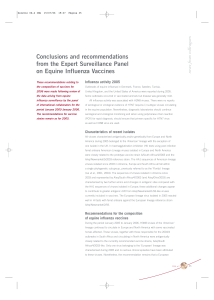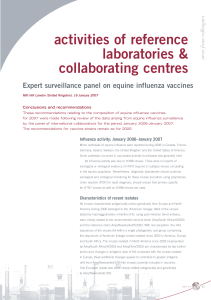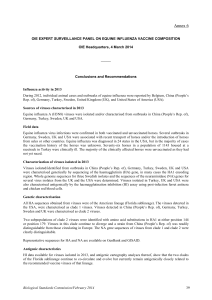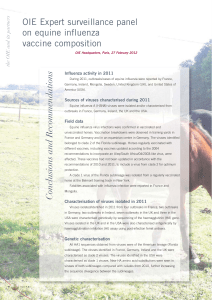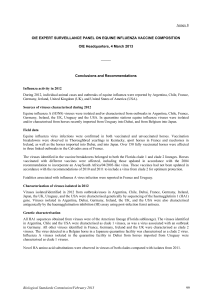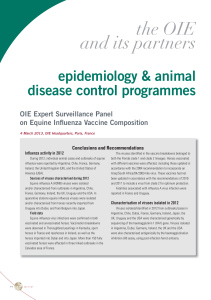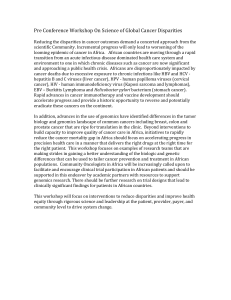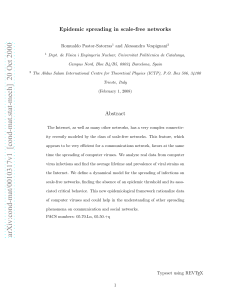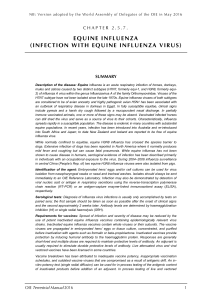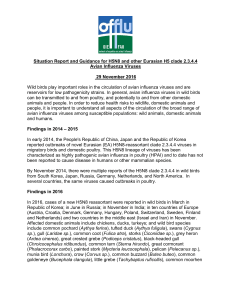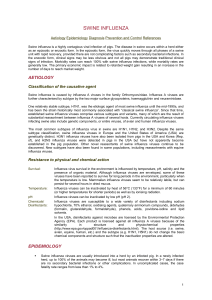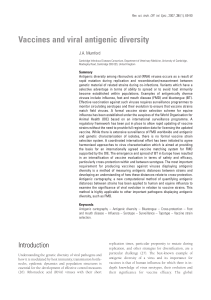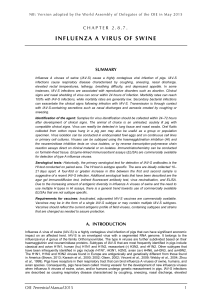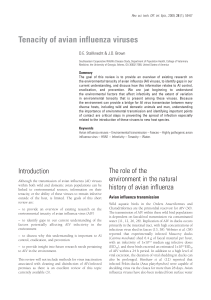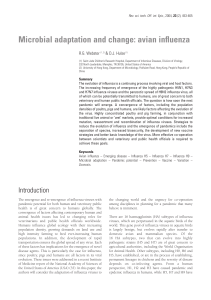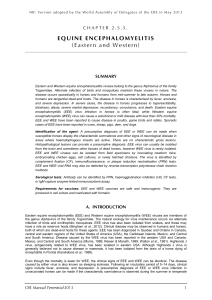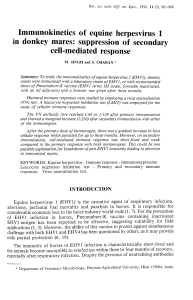D4908.PDF
publicité
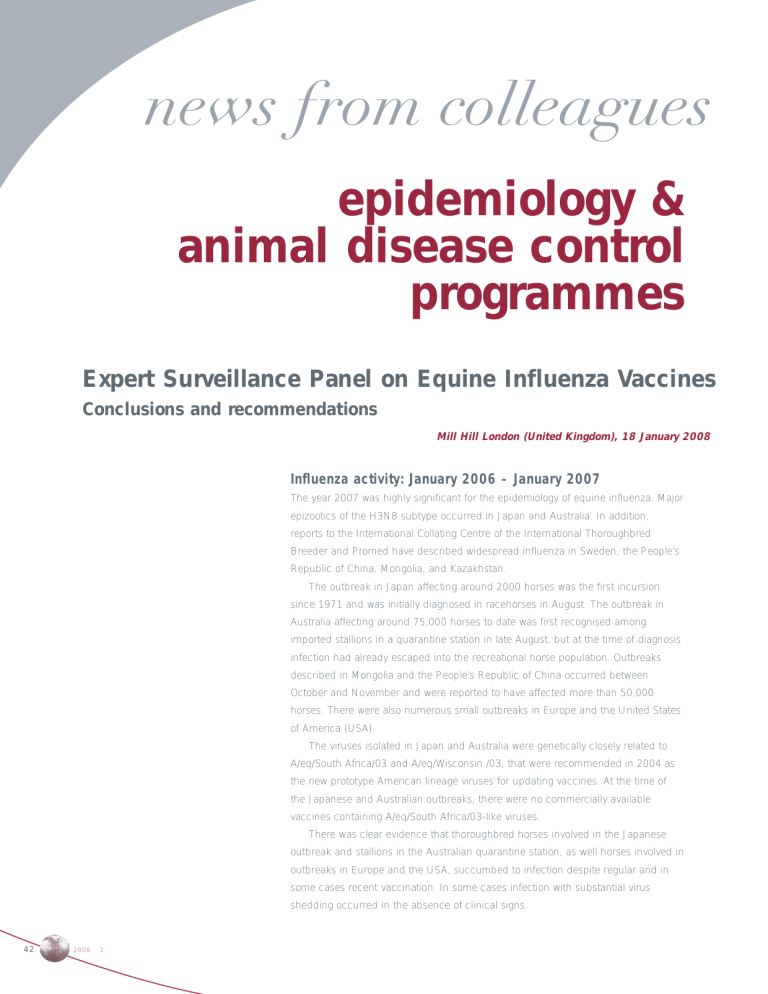
news from colleagues epidemiology & animal disease control programmes Expert Surveillance Panel on Equine Influenza Vaccines Conclusions and recommendations Mill Hill London (United Kingdom), 18 January 2008 Influenza activity: January 2006 – January 2007 The year 2007 was highly significant for the epidemiology of equine influenza. Major epizootics of the H3N8 subtype occurred in Japan and Australia. In addition, reports to the International Collating Centre of the International Thoroughbred Breeder and Promed have described widespread influenza in Sweden, the People’s Republic of China, Mongolia, and Kazakhstan. The outbreak in Japan affecting around 2000 horses was the first incursion since 1971 and was initially diagnosed in racehorses in August. The outbreak in Australia affecting around 75,000 horses to date was first recognised among imported stallions in a quarantine station in late August, but at the time of diagnosis infection had already escaped into the recreational horse population. Outbreaks described in Mongolia and the People’s Republic of China occurred between October and November and were reported to have affected more than 50,000 horses. There were also numerous small outbreaks in Europe and the United States of America (USA). The viruses isolated in Japan and Australia were genetically closely related to A/eq/South Africa/03 and A/eq/Wisconsin /03, that were recommended in 2004 as the new prototype American lineage viruses for updating vaccines. At the time of the Japanese and Australian outbreaks, there were no commercially available vaccines containing A/eq/South Africa/03-like viruses. There was clear evidence that thoroughbred horses involved in the Japanese outbreak and stallions in the Australian quarantine station, as well horses involved in outbreaks in Europe and the USA, succumbed to infection despite regular and in some cases recent vaccination. In some cases infection with substantial virus shedding occurred in the absence of clinical signs. 42 2008 • 2 news from colleagues © Leopoldo Stuardo The Expert Surveillance Panel strongly urges vaccine manufacturers and licensing authorities to adopt the recommendations for updating vaccine strains for the American lineage viruses and facilitate their rapid licensing. Criteria applied to data submitted to assess the significance of antigenic drift for vaccine efficacy For the 2007 review of equine influenza, data on virus isolates from Australia, Japan, Ireland, the USA and the United Kingdom (UK) were considered. No viruses were received from other reported outbreaks. As part of the review of data submitted, the panel re-examined the criteria used for assessing antigenic variation and its potential significance for vaccine efficacy. It was agreed as follows: – Breakdown of vaccines containing earlier strains in the face of field infection with new strains despite up to date vaccination is an important criterion for the significance of antigenic drift. The data are considerably strengthened when infection is verified in horses with high levels of vaccinal antibody in acute phase sera (Newton et al., 1999) rather than relying on records of recent vaccination, as some animals respond poorly to vaccination. In 2007 such data were available from Japan, Australia, the UK and the USA. – Discrimination of viruses using haemagglutination inhibition (HI) tests with ferret antisera is currently the most reliable method of assessing antigenic relationships between viruses, particularly when these antigenic distances are depicted using antigenic cartography (Smith et al., 2004). All viruses isolated in 2007 were characterised as American lineage viruses in HI tests. – Discrimination between viruses in HI tests using post-vaccination field sera has been abandoned as equine sera from repeatedly vaccinated horses are highly cross reactive. – Attempts to measure cross-protection between strains in a hamster model (Daly et al., 2004) have also been abandoned as some equine viruses fail to replicate adequately in the hamster. – While it was recognised that cross-protection studies in horses are the gold standard (Mumford, 1998), the need to use large numbers of horses to gain statistically significant results and the lack of availability of seronegative animals at certain times of the year precludes this approach as a feasible criterion. 2008 • 2 43 news from colleagues – To date antigenic relationships measured by HI using ferret antisera have correlated with the outcome of cross-protection studies in horses (Mumford, 1998) and field observations (Newton et al., 1999). – Sequencing of the HA1 gene provides useful supporting data on genetic relationships between isolates. – Work is ongoing to compare the discriminatory power of horse antisera with ferret antisera in HI tests. Nomenclature of H3N8 strains Since the divergence of the HAs of H3N8 subtype viruses into American and Eurasian lineages, which occurred around 1989, this virus has continued to evolve into a number of sublineages or “clades”. Lai et al. (2001) described three sublineages of the American-like viruses, which were designated Argentina, Kentucky and Florida with the Kentucky lineage being the most prevalent group of viruses during the 1990s. The evolution of the Florida sublineage resulted in the appearance of variant viruses, represented by A/eq/South Africa/03, which could be distinguished antigenically from the original American lineage prototype viruses (A/eq/Newmarket1/93, A/eq/Kentucky/94) and © Leopoldo Stuardo this observation instigated the 2004 recommendations to update the American lineage virus vaccine component to an A/eq/South Africa/03-like virus. Within this sublineage, two groups of viruses with divergent HAs have been recognised, which for the sake of clarity are provisionally referred to as clades 1 and 2. Clade 1 includes viruses such as A/eq/South Africa/03 A/eq/Ibaraki/07 and A/eq/Sydney/07. Clade 2 is represented by A/eq/Newmarket/03. Clade 1 viruses have been isolated predominantly in the USA, Japan and Australia. Clade 2 viruses have been isolated in Europe. Their further evolution and relative prevalence is being monitored. Assessment of potential antigenic differences awaits the production of new reagents. No European lineage viruses were isolated in 2007. Thus, since 2003, when widespread infection by A/eq/South Africa/03-like and Newmarket/03-like viruses occurred, very few European lineage viruses have been recovered. Laboratories that isolate viruses are urged to submit them to OIE or WHO Reference Laboratories or other specialist laboratories for further analysis to enable current prevalence of the different variants to be assessed. 44 2008 • 2 Daly et al. (2004). – Evidence supporting Vaccines Many vaccines still contain American lineage viruses such as Kentucky/94 and the inclusion of two strains from each Newmarket/1/93, which were first recommended over 10 years ago. However, of the co-circulating lineages of the H3N8 because of the practice of some vaccine manufacturers of updating strains on an equine influenza virus in vaccines. Vaccine, ad hoc basis, other viruses such as A/eq/Kentucky/97, A/eq/Kentucky/98, and 22 (29-30), 4101-4109. A/eq/Kentucky/2002 have also been used. At the time of writing no vaccine Lai et al. (2004). – Alternate circulation of news from colleagues Reférences containing an A/eq/South Africa/03-like virus is available, although it is understood recent equine 2 influenza viruses (H3N8) that one vaccine manufacturer has updated and is currently completing the from two distinct lineages in the United licensing process. States. Virus Res., 199 (2), 159-164. from an international perspective. In Proc. The 2008 recommendations for equine influenza vaccine strains are as follows: 8th International Conference on Equine – There is no requirement for inclusion of an H7N7 virus. Infectious Diseases. R and W Ltd, – Manufacturers should adopt the 2004 recommendations and update the Newmarket, 11-24. American lineage H3N8 component of their vaccines to an A/eq/South Africa/ Mumford J.A. (1998). – Control of influenza Newton et al. (1999). – Equine Influenza 03-like virus. Other viruses such as A/eq/Wisconsin/03, A/eq/Ohio/03, in the United Kingdom in 1998. Vet. Rec., A/eq/Ibaraki/07 and A/eq/Sydney/07 are also suitable. 145 (16), 449-452. – Smith et al. (2004). – Mapping the antigenic There is no requirement to update the European lineage H3N8 virus component. Current strains in use are A/eq/Suffolk/89, A/eq/Newmarket2/93, and genetic evolution of influenza virus. A/eq/Borlange/91. If companies are considering including European viruses they Science, 305 (5682), 371-376. should consult with experts to establish the current situation and availability of recent isolates. Standard reagents Reference reagents specific for the recommended European lineage vaccine strains are available for standardisation of vaccine content by single radial diffusion (SRD) assay and can be obtained from the National Institute of Biological Standards and Control (NIBSC; email: [email protected]). Preparation of South Africa/03-like viruses is under review. Four equine influenza horse antisera against A/eq/Newmarket/77(H7N7), A/eq/Newmarket/1/93(H3N8), A/eq/Newmarket2/(H3N8) and A/eq/South Africa/03(H3N8) are available as European Pharmacopoeia Biological Reference Preparations for serological testing of vaccine responses using the single radial haemolysis test. Sera may be sourced from the European Directorate for the Quality of Medicines and HealthCare (EDQM; www.pheur.org). 2008 • 2 45
